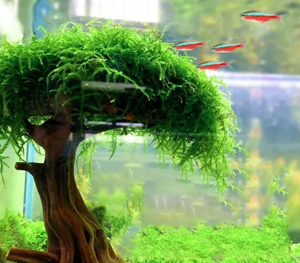Explore the aquatic world of Java Moss for aquarium– an adaptable and lively plant that effortlessly flourishes in any water habitat.
Whether you’re a skilled aquarium enthusiast or a newbie who is starting this new venture, this all-in-one guide provides a valuable understanding of how to plant java moss, how long does moss take to grow, and benefits of java moss.
From establishing the perfect environment to enjoying the benefits of java moss, immerse yourself into a realm of moss for fish tanks with our advice for caring for java moss for aquarium.
How Long Does Moss Take to Grow?
Before we tell you, how long does moss take to grow, you must know what is java moss and from where it originates!
Java moss, or Vesicularia dubyana, is a tropical invasive species that has its origins in Southeast Asia. It happens to be a member of the Hypnaceae family and is commonly used to decorate your freshwater aquarium.
As a result of its versatility, it becomes challenging to get rid of it from aquariums at home once moss for fish tanks establishes itself. Java moss for aquarium typically takes three to four weeks to establish and grow.
Although it can be found in tropical climates on a variety of surfaces, its best growth happens when it is submerged in water. This moss for fish tanks can grow by about 1-1.5 inches every month in ideal circumstances.
Disclosure: This article contains affiliate links. When you follow a link to purchase the products, I sometime earn a commission, at no additional cost to you. Read my full disclosure here.
Conditions and Requirements for How to Plant Java Moss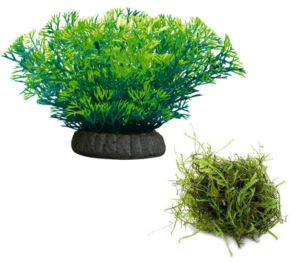
We understand that you are extremely eager to learn, “how to plant java moss”, but before we take you through it, let us tell you the conditions required for how to plant java moss.
Java Moss for aquarium flourishes when it gets the feel of natural Southeast Asian habitat. It easily attaches itself to different surfaces like substrate, driftwood, rocks, and decorations.
To encourage moss for fish tanks growth, provide moderate or low lighting for 8-10 hours each day since it prefers shady conditions in its natural environment. Keep the water temperature around 75°F to ensure optimal growth of Java Moss for aquarium.
Here are the ideal required conditions for how to plant java moss;
| Water Type | Slightly acidic to neutral |
| Water Temperature | 59–86°F |
| Amount of Water | 5 Gallons |
| Water pH | 5.0–8.0 pH |
| Water Hardness | 6–20 dGH |
| Light | Low to moderate |
| Hours of Light | 10 hours |
| Substrate | Not necessary |
How to Plant Java Moss?
So, after you have gathered all the necessary equipment, the question is; how to plant java moss and set up a beautiful java moss for fish tanks. Here we have summarized the whole process in very easy and basic steps. Have a look!
Setting up Tank for How to Plant Java Moss
- Tank Size and Water
Select a freshwater tank larger than 5 US gallons (19 liters). Java moss for fish tanks isn’t suited for marine tanks. Keep enough space to avoid crowding. While it can tolerate slightly brackish water, it prefers fresh water. Tap water is fine, but you might need chemicals to make it safe for plants and fish.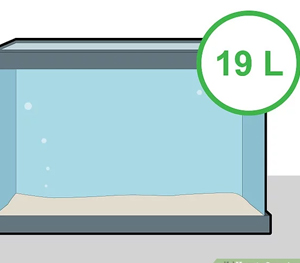
- Temperature and Heater
Maintain a steady water temperature between 70–75 °F (21–24 °C) using a heater. Java moss for fish tanks can handle up to 90 °F (32 °C), but it grows slower at higher temperatures.
So, if you’re wondering how long does moss take to grow, you better monitor its temperature with a floating thermometer.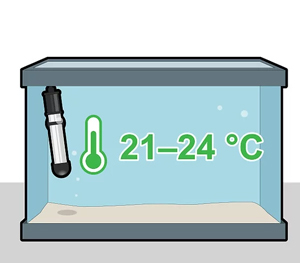
- Maintain pH
Maintain the pH level within the range of 5-8. Use a pH kit to test the water and make necessary adjustments by using chemicals available in stores, if required.
It is recommended to conduct regular tests after each water change and think about adding shells or rocks to regulate the pH levels of java moss for aquarium.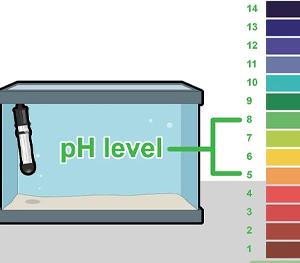
- Water Circulation
For effective water circulation and filtration, install a suitable filter that promotes cleanliness and even distribution of nutrients throughout the tank.
A gentle current created by the filter system can be beneficial for moss growth during the root establishment stage. However, it is important not to place java moss for aquarium in direct contact with strong flow coming from the filter.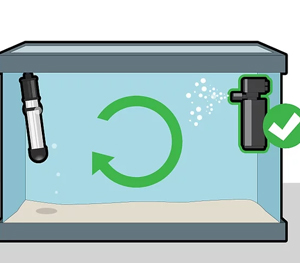
- Lighting
Use LED or fluorescent overhead lighting. While low lights result in darker, thinner moss, bright lights promote the rapid, dense growth of moss for fish tanks. Be aware that the growth of algae can be aided by brighter lighting.
By following these easy steps, you can help your aquarium become aesthetically and can enjoy the benefits of Java Moss too.
Adding Java Moss
Now, coming to the main part of how to plant java moss- adding java moss!
- Add Moss: Adding some moss to the water’s surface will make it float. Let moss for fish tanks develop into a plant that floats. Be aware that it could drift and become impaled by a filter.
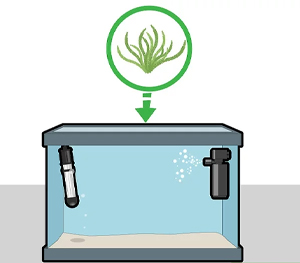
- Attach to Driftwood or Rock: Fasten the moss to the driftwood or rock by thread or fishing line and tie a knot. This aids the roots’ ability to cling to the wood or rock. You can cut the thread after about a month.
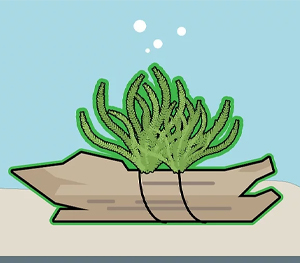
- Construct a Wall or Carpet: To construct a wall or carpet, place the moss for fish tanks in the space between two layers of plastic mesh. One mesh should be covered with moss, and the edges should be threaded shut
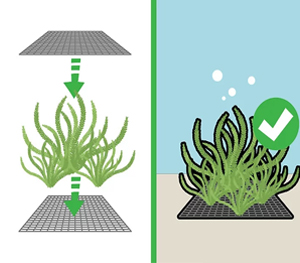
- Allow Moss to Settle: After placing the java moss for aquarium, leave it alone for a few weeks without touching it. Let it adjust to the surroundings of the tank.
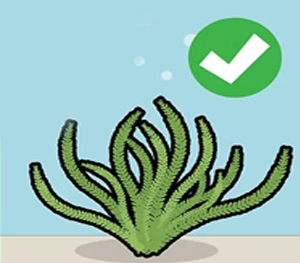
Remember that the answer to your question, how long does java moss take to grow depends on the environment you provide.
For Java Moss to thrive in your aquarium, it needs time to establish itself. Stick to the steps for how to plant java moss for aquarium.
Aquascaping Java Moss for Fish Tanks
Java Moss for aquarium is an adaptable aquatic plant that does not possess conventional roots. What makes it best is its ability to survive on multiple surfaces, whether they are flat or vertical.
So, let’s move forward to learn how Java moss can be used in different ways for aquascaping!
Java Moss Carpet/Walls
One way to create an eye-catching Java Moss carpet or wall feature in your tank is by using a simple DIY method.
First, gather two pieces of non-toxic mesh and fishing line or thread. Begin by placing one piece of mesh on the bottom and arranging fragments of Java Moss on it. Then, secure the second piece of mesh on top with thread creating a “moss sandwich.”
Next, carefully introduce this moss for fish tanks creation into your tank. If you prefer another option, you can also create a moss carpet by lightly covering the moss with gravel to anchor it to the floor of your tank.
Java Moss Tree
Elevating the aesthetic appeal of your aquarium can be achieved by incorporating mossy trees made with Java Moss for fish tanks.
To create this unique addition, simply fasten the Java Moss to a vertical piece of driftwood that resembles a tree with branches. Another option is to assemble several pieces of wood in the shape of a tree, making sure to use an adhesive that is safe for aquariums.
Apply small amounts of glue on the branches and attach pieces of moss onto them. Finally, trim any excess strands and introduce your moss tree into your tank.
Care and Maintenance of Java Moss for Aquarium
- Cleaning Method: Keeping the tank clean is very important to prevent the buildup of waste and uneaten food. This not only affects the appearance of the java moss for aquarium but also impacts water quality.
- Efficient Cleaning: To remove moss for fish tanks from driftwood or rocks, simply take it out and rinse it under running water.
- Frequent Trimming: Trimming Java Moss for aquarium with scissors helps control its growth rate and allows better penetration of light. This ensures that new growth isn’t blocked by older parts of the plant.
- Improving Appearance: Regular trimming doesn’t just maintain tidiness, but also prevents old and new growth from tangling together, making your moss for fish tanks look more visually appealing.
Benefits of Java Moss for Aquarium
- Aquarists favor moss: not only because of its ease of maintenance but for the amazing benefits of java moss. It has a lush, furry appearance and various shades of green.
- Enhancement of the Ecosystem: Java Moss for fish tanks helps convert harmful substances and contributes to the development of a healthy ecosystem inside the aquarium.
- Improves Water Quality: Ammonia, nitrates, and nitrite levels are decreased thanks to this plant, which improves the water’s quality and the habitat for aquatic life.
- Increases Shrimp Survival: Java moss is a fantastic refuge for baby shrimp, which is especially beneficial for shrimp tanks. It increases survival rates by offering a haven of safety.
- Expanded Grazing Area: The moss for fish tanks expands the area that prawns can graze on, which is beneficial to their health and natural behavior.
- Breeding Home: Java moss serves as a favorable home for essential microorganisms necessary for the survival of young prawns.
- Easy to Maintain: Java Moss for aquarium is suitable for beginners because it requires little maintenance.
The Best Recommended Java Moss for Aquarium
1. Java Moss – Vesicularia dubyana
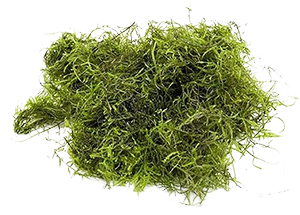 Quick view on Amazon
Quick view on Amazon
Available in: Australia, Canada, UK and US
2. Java Moss Pebbles
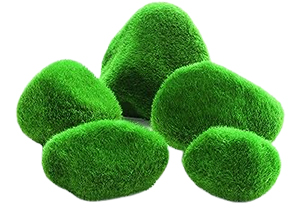
Quick view on Amazon
Available in: Australia, Canada, UK and US
3. Fluval Betta Moss Ball
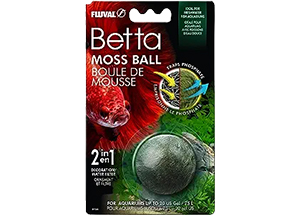
Quick view on Amazon
Available in: Australia, Canada, UK and US
Wrap Up
If you’re looking for a sturdy and low-maintenance option, Java Moss for aquarium is the perfect choice. Its resilience and adaptability make it incredibly easy to grow.
So, make sure you stick to our guide if you want to watch your aquarium flourish. Also, don’t forget to share it with another aquarium hobbyist as well who is trying to seek help for how to plant java moss in aquarium.

